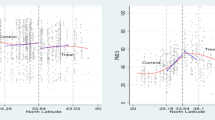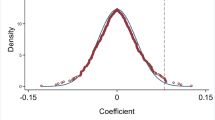Abstract
This study examines the relationship between corporate diversification strategy and the pollution activity of subsidiaries within the U.S. chemical industry using TRI data (EPA's Toxic Release Inventory). The subsidiaries of conglomerates were found to exhibit higher pollution levels for direct emissions than those of firms pursuing more related diversification strategies. Additionally, the subsidiaries of conglomerates exhibited more variance in overall pollution emissions compared to related diversified firms.
Similar content being viewed by others
References
Anderson, J. C., M. Rungtusanatham and R. G. Schroeder: 1994, ‘A Theory of Quality Management Underlying the Deming Management Method’, Academy of Management Review 19, 472–509.
Ansoff, H. I.: 1984, Implanting Strategic Management (Prentice Hall, Englewood Cliffs, NJ).
Aragon-Correa, J. A.: 1998, ‘Strategic Proactivity and Firm Approach to the Natural Environment’, Academy of Management Journal 41, 556–567.
Arlow, P. and M. Gannon: 1982, ‘Social Responsiveness, Corporate Structure, and Economic Performance’, Academy of Management Review 7, 235–241.
Baysinger, B. D. and R. E. Hoskisson: 1989, ‘Diversification Strategy and RandD Intensity in Large Multiproduct Firms’, Academy of Management Journal 32, 310–332.
Baysinger, B. D. and R. E. Hoskisson: 1990, ‘The Composition of Boards of Directors and Strategic Control: Effects on Corporate Strategy’, Academy of Management Review 15, 72–87.
Bettis, R. A.: 1981, ‘Performances Differences in Related and Unrelated Diversified Firms’, Strategic Management Journal 2, 379–393.
Buccholz, R. A.: 1993, Principles of Environmental Management (Prentice Hall, Englewood Cliffs, NJ).
Carroll, A. B.: 1979, ‘A Three-Dimensional Model of Corporate Performance’, Academy of Management Review 4, 497–505.
Child, J.: 1984, Organization: A Guide to Problems and Practice (Harper and Row, London).
Dean, J. W. and D. E. Bowen: 1994, ‘Management Theory and Total Quality: Improving Research and Practice through Theory Development’, Academy of Management Review 19, 392–418.
Dubofsky, P. and P. Varadarajan: 1987, ‘Diversification and Measures of Performance: Additional Empirical Evidence’, Academy of Management Journal 30, 597–608.
E.P.A.: 1991, Toxics in the Community: 1989 National and Local Perspective (U.S. Government Printing Office, Washington, DC).
Fowler, D. M. and T. J. Dean: 1993, Managing Environmental Issues in Business: A New Source of Competitive Advantage? Paper presented at the Academy of Management Annual Meeting, Atlanta.
Galbraith, J.: 1982, ‘Designing the Innovating Organization’, Organizational Dynamics 10, 5–25.
Gleckman, H. and R. Krut: 1997, ‘Neither International nor Standard: The Limits of ISO 14001 as an Instrument of Global Corporate Environmental Management’, in C. Sheldon (ed.), ISO 14001 and Beyond (Greenleaf Publishing, Sheffield, U.K.).
Gomez-Mejia, L. R.: 1992, ‘Structure and Process of Diversification, Compensation Strategy, and Firm Performance’, Strategic Management Journal 13, 381–397.
Gomez-Mejia, L. R. and D. B. Balkin: 1992, Compensation, Organizational Strategy, and Firm Performance (Southwest Publishing, Cincinnati, OH).
Gore, A.: 1992, Earth in the Balance: Ecology and the Human Spirit (Houghton-Mifflin, Boston).
Govindarajan, V. and J. Fisher: 1990, ‘Strategy, Control Systems, and Resource Sharing: Effects on Business Unit Performance’, Academy of Management Journal 33, 259–285.
Grant, R., A. Jammine and H. Thomas: 1986, ‘The Impact of Diversification Strategy upon the Profitability of British Manufacturing Firms’, Academy of Management Proceedings, 26–30.
Griffin, J. J. and J. F. Mahon: 1997, ‘The Corporate Social Performance and Corporate Financial Performance Debate: Twenty-Five Years of Incomparable Research’, Business and Society 36, 5–31.
Haines, L.: 1989, ‘The Green Barrage’, Business Month (December), 69–74.
Hill, C. W. and S.A. Snell: 1988, ‘External Control, Corporate Strategy, and Firm Performance in Research Intensive Industries’, Strategic Management Journal 9, 577–590.
Hill, C. W., M. A. Hitt and R. E. Hoskisson: 1992, ‘Cooperative versus Competitive Structures in Related and Unrelated Diversified Firms’, Organization Science 3, 501–521.
Holcomb, J. M.: 1992, ‘How the Greens Have Grown’, Business and Society Review, 20–25.
Hoskisson, R. E. and R. A. Johnson: 1992, ‘Corporate Restructuring and Strategic Change: The Effect on Diversification Strategy and RandD Intensity’, Strategic Management Journal 13, 625–634.
Hoskisson, R. E., M. A. Hitt, R. A. Johnson and D. D. Moesel: 1993, ‘Construct Validity of an Objective (Entropy) Categorical Measure of Diversification Strategy’, Strategic Management Journal 14, 215–235.
Jones, G. R. and W. L. Hill: 1988, Transaction Cost Analysis of Strategy-Structure Choice’, Strategic Management Journal 9, 159–172.
Keats, B. W. and M. A. Hitt: 1988, ‘A Causal Model of Linkages among Environmental Dimensions, Macro Organizational Characteristics, and Performance’, Academy of Management Journal 31, 570–598.
Kerr, J. L.: 1985, ‘Diversification Strategies and Managerial Rewards: An Empirical Study’, Academy of Management Journal 28, 155–179.
Leontidas, M.: 1980, Strategies for Diversification and Change (Little, Brown and Co., Boston, MA).
Logsdon, J. M.: 1995, ‘The Toxics Release Inventory as a Data Source for Business and Society Studies’, in D. Collines (ed.), Proceedings from the International Association of Business and Society, 648–653.
Malueg, D. A.: 1989, ‘Emission Credit Trading and the Incentive to Adopt New Pollution Abatement Technology’, Journal of Environmental Economics and Management 16, 52–57.
Markides, C. C. and P. J. Williamson: 1994, ‘Related Diversification, Core Competences and Corporate Performance’, Strategic Management Journal 15, 149–165.
Mintzberg, H.: 1983, Structure in Fives: Designing Effective Organizations (Prentice Hall, Englewood Cliffs, NJ).
Monty, R. L.: 1991, ‘Beyond Environmental Performance: Business Strategies for Competitive Advantage’, Environmental Finance (Spring), 3–11.
Neter, J., W. Wasserman and M. H. Kutner: 1990, Applied Linear Statistical Models, 3rd ed. (Richard D. Irwin, Inc., Homewood, IL).
Ouchi, W. G.: 1980, ‘Markets, Bureaucracies, and Clans’, Administrative Science Quarterly 25, 129–141.
Palepu, K.: 1985, ‘Diversification Strategy, Profit Performance, and the Entropy Measure’, Strategic Management Journal 6, 239–255.
Pitts, R. A. and H. D. Hopkins: 1982, ‘Firm Diversity: Conceptualization and Measurement’, Academy of Management Review 7, 620–629.
Porter, M. E.: 1987, ‘From Competitive Advantage to Corporate Strategy’, Harvard Business Review (May-June), 43–59.
Porter, M. E.: 1991, ‘Green Competitiveness’, Scientific American (April), 1–2.
Rappaport, A. and M. F. Flaherty: 1992, Corporate Responses to Environmental Challenges (Quorum Books, Westport, CT).
Roper Organization: 1990, The Environment: Public Attitudes and Individual Behavior, July.
Rowe, W. G. and P. M. Wright: 1997, ‘Related and Unrelated Diversification and Their Effect on Human Resource Management Controls’, Strategic Management Journal 18, 329–338.
Rumelt, R. P.: 1974, Strategy, Structure and Economic Performance (Harvard University Press, Cambridge, MA).
Sanchez, C. M.: 1997, ‘Environmental Regulation and Firm-Level Innovation: The Moderating Effects of Organizational-and Individual-Level Variables’, Business and Society 36, 116–139.
Schmidheiny, S.: 1992, Changing Course: A Global Business Perspective on Development and the Environment (MIT Press, Cambridge, MA).
Shrivastava, P.: 1995, ‘Environmental Technologies and Competitive Advantage’, Strategic Management Journal 16, 183–200.
Shrivastava, P. and S. Hart: 1992, Creating Sustainable Corporations. Paper presented at the annual meeting of the Academy of Management, Las Vegas, Nevada.
Snedecor, G. W. and W. G. Cochran: 1980, Statistical Methods, 7th ed. (Iowa State University Press, Ames, Iowa).
Teece, D. J.: 1982, ‘Towards an Economic Theory of the Multiproduct Firm’, Journal of Economic Behavior and Organization 3, 39–63.
Varadarajan, P. and V. Ramanujam: 1987, ‘Diversification and Performance: A Reexamination Using a New Two-Dimensional Conceptualization of Diversity in Firms’, Academy of Management Journal 30, 380–397.
Waddock, S. A. and S. B. Graves: 1997, ‘The Corporate Social Performance – Financial Performance Link’, Strategic Management Journal 18, 303–319.
Watanabe, C.: 1992, ‘Trends in the Substitution of Production Factors to Technology: Empirical Analysis of the Inducing Impacts of the Energy Crisis on Japanese Industrial Technology’, Research Policy 21, 481–505.
Williamson, O. E.: 1975, Markets and Hierarchies: Analysis and Antitrust Implications (The Free Press, New York).
Williamson, O. E.: 1985, The Economic Institutions of Capitalism (The Free Press, New York).
Wood, D. J.: 1991, ‘Social Issues in Management: Theory and Research in Corporate Social Performance’, Journal of Management 17, 383–406.
Author information
Authors and Affiliations
Rights and permissions
About this article
Cite this article
Dooley, R.S., Fryxell, G.E. Are Conglomerates Less Environmentally Responsible? An Empirical Examination of Diversification Strategy and Subsidiary Pollution in the U.S. Chemical Industry. Journal of Business Ethics 21, 1–14 (1999). https://doi.org/10.1023/A:1006221229985
Issue Date:
DOI: https://doi.org/10.1023/A:1006221229985




